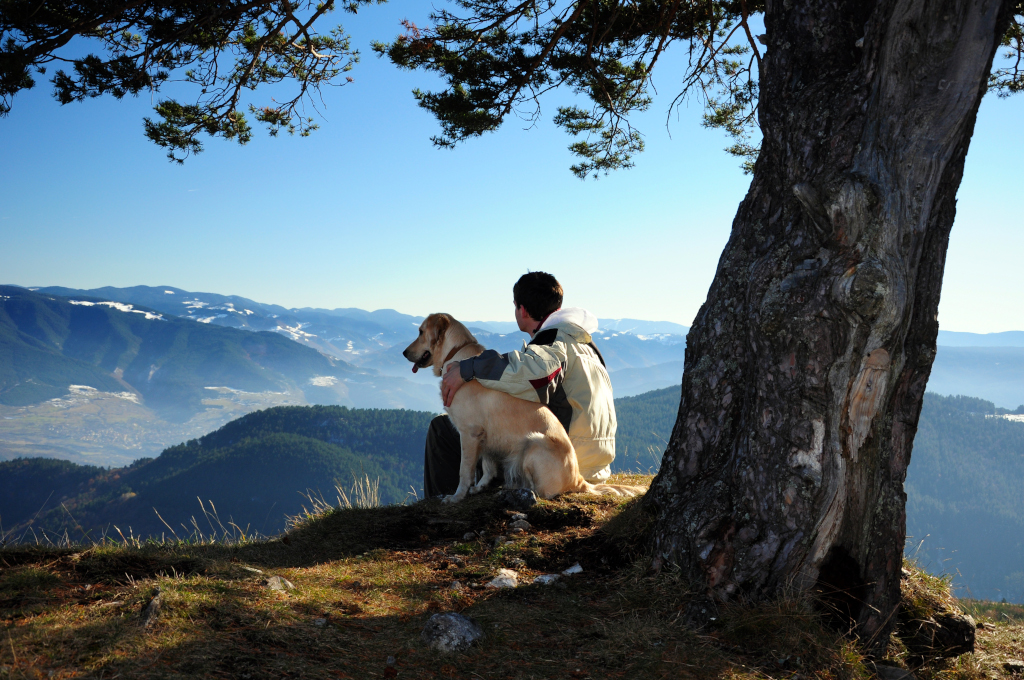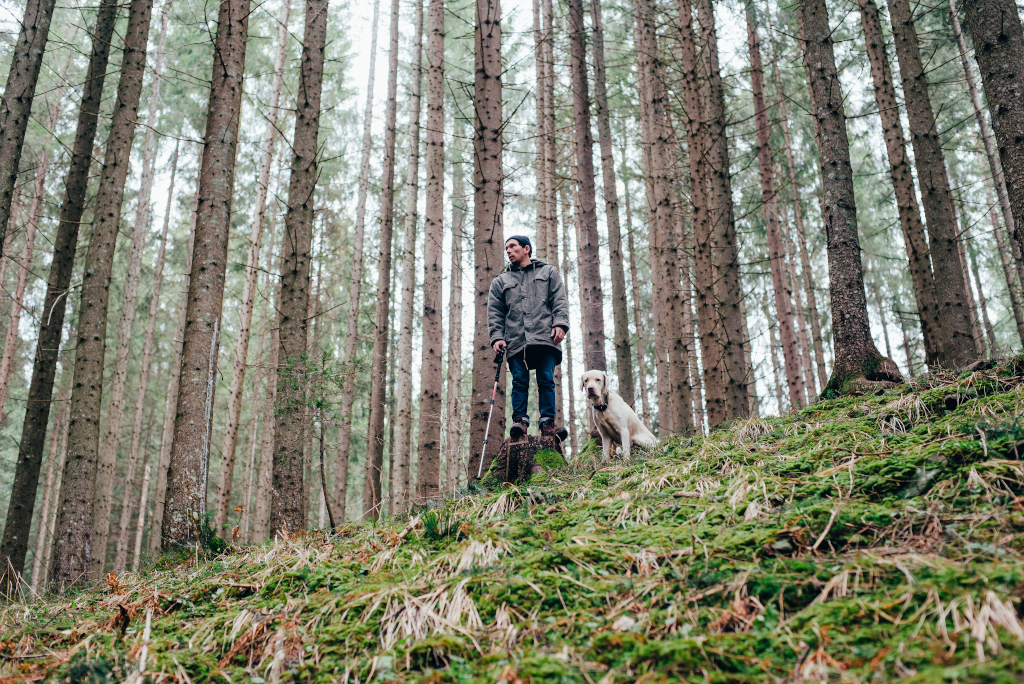It’s not uncommon to see people hiking with their dogs. But what about long-distance hikes? Some might think it’ll be too difficult, or even impossible to do, but don’t let that stop you!
While hiking long distances with dogs may seem like a difficult feat, there are things you can do which will make your hike easier and more enjoyable with your canine friend.
If you’re considering taking on this challenge, here are a few things you should know before setting out into the wilderness with your four-legged hiking buddy.

1. Know Your Dog's Limits
Whether your canine is 10 pounds or 100 pounds, every dog has their own limitations when it comes to strenuous activities. Make sure not to overdo it in terms of distance.
2. Make Sure Your Dog Is In Good Health
Before you ever even go out on a hike, make sure your dog is in good shape to handle it. If your dog is sick, injured, or too young, it’s always best to give this idea a pass!
This will help make things easier for them while also reducing the chances of anything bad happening from being out on the trail all day. If you have any concerns at all, it’s probably best to consult a veterinarian.
3. Check The Regulations
Before hitting the trails, you’ll want to check with the national park or the governing body for any specific rules and regulations regarding dogs in the area where you are going to be hiking. This way, you won’t risk getting a fine on top of whatever else may have happened during your hike.
4. You Don't Have To Hike Long Distances Right Away
If you’re not ready to attempt long-distance hiking with your dog, that’s okay! There are many other things you both can do together, so don’t feel pressured to tackle something you may not be comfortable with right away.
5. Start With Shorter Hikes
If your dog has never done anything more strenuous than walking around your neighborhood, then it’s better to start with shorter hikes. And gradually build up the miles so that they can get used to longer distances without getting overly tired or worn down too quickly.
6. If Your Dog Isn't Used To Being In The Woods, Start With An Easy Trail
Tackling a difficult trail right out of the gates isn’t always the best idea since this is something that many dogs are not used to and could become scared by.
There’s nothing wrong with starting your pup off on something more gentle like the Catalina Canyon Loop Trail in Tucson. This allows them to build up their endurance before tackling something even more challenging later on down the road.
7. Make Sure Your Dog Is Properly Trained
This is so important because it not only means your dog can follow commands from you but also helps to protect others on the trail who may be afraid of dogs. Being able to control your pup no matter when or where something happens can help significantly when out in the wilderness with nothing but yourself and your dog.
Read More: How To Train Your Canine For Hiking
8. Set A Pace That Fits Your Dog
If you try pushing your furry hiking buddy too hard or at too quick of a pace, this could put a damper on things, which no one wants! So, find a happy medium speed that they can keep up, although it may take some time before you can find what works best for your dog.

9. If Your Dog Is Scared, It's Okay To Turn Around
There’s no shame in giving something new a shot, but if your pup is too scared or feeling uneasy about something, then this could cause serious problems for both you and them during the hike! So don’t feel bad about heading back home if things aren’t working out properly.
10. Check The Weather
Before embarking on your hike, check the weather forecast to ensure you know what conditions you’re going to be facing as your hike goes on. Knowing this will help prepare you and allow you to pack accordingly!
11. Watch For Signs Of Overheating
Heat exhaustion is one of the most dangerous things that your dog can experience while out on a hike, especially if they are left in the heat for too long. So, make sure you check on them throughout the hike to ensure that they don’t get too hot, and if they do, take a break, give them plenty of drinking water, and find some shade where they can cool off.
12. Hydration Is Key!
Whether you’re going to tackle a 5- or 30-mile hike, the most important thing is making sure your pup stays hydrated through the whole trail. It may seem like common sense, but many hikers often forget to pack water for their dogs, and as a result, end up with a sick pup who couldn’t keep up because of dehydration.
Read More: Tips For Carrying Water For Dogs While Exercising
13. Be Sure To Schedule In Breaks
Just like us, dogs need time to stop and rest. Not only will this allow them time to recuperate but also provide an excellent opportunity for both of you to take in the views at different points during the hike, rather than having everything go by in one big blur! So feel free to take breaks whenever necessary, and don’t feel like you need to push yourself or your pup too hard when it’s already hot outside.
14. Monitor Your Pup's Behavior Throughout The Hike
If your pup is acting a bit off, then it may be time for you to bring them home before they become sick! There’s nothing worse than heading into a long hike when your four-legged friend isn’t feeling well and has to deal with that the entire time.
15. Plan The Hike Ahead Of Time
If you’re planning a long hike, it’s best to set up a plan for the trail ahead of time. This could include how far you’ll hike and where you’ll spend the night if necessary. Make sure your family and friends are aware of your plan as well in case something happens.
16. Pack The Essentials
No matter how long your hike is, you will always need to pack certain things to ensure your canine is as safe as possible. That includes food, water bottles, bowls, waste bags for cleaning up after your fido, maps, and a compass in case GPS fails you.
17. Be Sure To Bring A Leash and Harness
You will always need to bring a leash and a hiking harness for your canine companion. Even if your pup is well behaved, you should still bring one as there are always people who aren’t comfortable around dogs. This will help keep everyone safe and happy on the trail.
18. Make Sure Your Dog Has Proper Footwear
Your pup can get hurt without proper footwear. So you’ll want to make sure that their paws are protected at all times, especially if you are taking a challenging hike like the Mount Olympus Trail in Utah. And this is most easily done by buying them the right kind of dog shoes explicitly made for hiking!
Read More:

19. Make Sure Your Pup Has Proper Identification On Them At All Times
There’s nothing worse than heading out on a long hike with your pooch and having them get lost and never be able to find them again. So, ensure your pup wears proper identification and that it is up-to-date before hitting the trail. Of course, that also means you would want to microchip your canine or invest in a dog GPS collar tracker!
20. Pack A Basic First-Aid Kit
You never know what kind of situations could arise in the great outdoors. Even if everything goes according to plan, bringing along supplies for emergencies is always a great idea when hiking long distances with your dog. That will ensure that your pup is taken care of should anything happen during your adventure.
Read More: Items You Need To Include In Your Dog’s First Aid Kit
21. Use A Dog Hiking Pack
Using a dog hiking pack is always an excellent idea when you’re going on long hikes. This allows your dog to carry their own supplies, which can be a huge help when it comes to keeping the extra weight off of your shoulders.
22. Keep Things Fun & Positive
The most important of all is to keep your pup excited about the hike and make sure that they are having fun so that they look forward to it. This means you would want to bring along their favorite toys and play fetch or tug-of-war with them on little breaks in between!
23. Have A Backup Plan
It’s crucial to have a backup plan just in case things don’t go as planned. This might mean packing more food than you think you’ll need, bringing your dog an extra harness, leash, warm coat, or life jacket. Always be ready for anything!
24. Stay On The Trail
It’s never a good idea to veer off the path while hiking long distances with your dog. Not only does this pose the chance of something terrible happening, but that can also damage the plants and harass the wildlife in the area. So, stay on the designated path no matter what so that things remain safe for everyone.
25. Watch Out For Ticks And Fleas
It is possible for your pup to get diseases in the woods if a tick or flea bites them! So be sure to bring a tick removal tool and check your canine companion throughout the hike for any of these critters that could end up causing problems for them.
26. Don't Bring Your Dog On A Hike If It's Not the Right Time Of Year
Some dogs just aren’t suited for long-distance hiking during certain seasons. For instance, winter hikes or snowshoeing can be pretty tricky and should be approached with great care, as your pup could get frostbite, especially if they have a short coat and don’t tolerate cold well!
27. Remember That Your Dog Isn't A Machine
Never push your dog too far, and remember that they aren’t a machine! Taking breaks is essential, and so is calling off your hike if anything bad happens along the way. It’s always best to err on the side of caution when out exploring nature together!
Conclusion
Hiking long distances with dogs can be a fun and rewarding experience, but it’s crucial to prepare for the adventure beforehand.
The tips above will ensure that you have an enjoyable time out on the trail with your four-legged best friend! And always remember that safety is the number one priority when exploring the great outdoors with your canine companion.
If this blog post has been helpful in any way, please share it with your friends who have dogs and would like more information about hiking with their furry family members.

